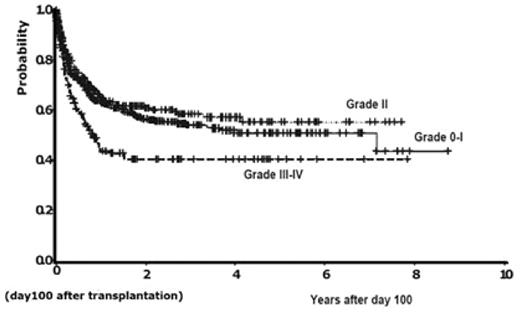Abstract
BACKGROUND Limited information is available on incidences and clinical features of acute graft-versus host disease (GVHD) after cord blood transplantation and large-sized researches have been awaited.
METHODS We investigated the incidences and clinical features of acute GVHD in 2,015 patients reported to the Japan Cord Blood Bank Network, who underwent cord blood transplantation between June 1997 and August 2006.
RESULTS Of 2,015 patients, 1481 patients (73%) achieved neutrophil engraftment at a median of day 22 (range, 6–81). Cumulative incidence of neutrophil recovery at day 100 was 0.74 (95%CI, 0.73–0.76). Of 2015 patients, 708 patients developed grade II-IV acute GVHD: grade II (n=423), grade III (n=237), and grade IV (n=48). The median onset was day 19 (range, 4–190). The cumulative incidences of grade II-IV and III-IV acute GVHD at day 100 were 0.35 (95% CI, 0.33–0.37) and 0.14 (95% CI, 0.12–0.15), respectively. Skin and gastrointestinal acute GVHD was documented in 1,006 and 405 patients, respectively, whereas liver GVHD was diagnosed in 149 patients. Multivariate analysis identified the following predictors of grade II-IV acute GVHD: the number of infused nucleated cells, transplantation from female donors to female recipients, TBI-containing preparative regimens, methotrexate-containing GVHD prophylaxis, and tacrolimus-based GVHD prophylaxis. Overall survival rates at three years of patients with grade 0-I, II and III-IV GVHD who survived 100 days or longer were 0.58 (95%CI, 0.53–0.63), 0.61 (95% CI, 0.54–0.67) and 0.40 (95%CI, 0.31–0.49), respectively.
CONCLUSIONS Acute GVHD following cord blood transplantation is mild and has graft-versus malignancy effects.
Probability of event free survival after cord blood tranplantation in the patients with grade 0-I, II and III-IV who survived 100 days or longer Event - free survival of the patients with grade 0-I, II and III-IV GVHD who survived 100 days or longer was 0.54 (95% CI, 0.49–0.59), 0.58 (95%CI, 0.52–0.65) and 0.41 (95%CI, 0.32–0.49),respectively,3 years after transplantation.
Probability of event free survival after cord blood tranplantation in the patients with grade 0-I, II and III-IV who survived 100 days or longer Event - free survival of the patients with grade 0-I, II and III-IV GVHD who survived 100 days or longer was 0.54 (95% CI, 0.49–0.59), 0.58 (95%CI, 0.52–0.65) and 0.41 (95%CI, 0.32–0.49),respectively,3 years after transplantation.
Author notes
Disclosure:Research Funding: This work was partially supported by a Research Grant on Tissue Engineering (H17–14) from the Ministry of Health, Labor and Welfare of Japan.


This feature is available to Subscribers Only
Sign In or Create an Account Close Modal